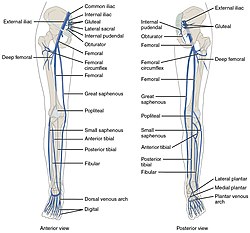|
Popliteal vein
The popliteal vein is a vein of the lower limb. It is formed from the anterior tibial vein and the posterior tibial vein. It travels medial to the popliteal artery, and becomes the femoral vein. It drains blood from the leg. It can be assessed using medical ultrasound. It can be affected by popliteal vein entrapment. StructureThe popliteal vein is formed by the junction of the venae comitantes of the anterior tibial vein and the posterior tibial vein at the lower border of the popliteus muscle. It travels on the medial side of the popliteal artery.[1] It is superficial to the popliteal artery.[2] As it ascends through the fossa, it crosses behind the popliteal artery so that it comes to lie on its lateral side. It passes through the adductor hiatus (the opening in the adductor magnus muscle) to become the femoral vein.[1][3] TributariesThe tributaries of the popliteal vein include:
VariationThe popliteal vein may be doubled in up to 35% of people.[2] FunctionThe popliteal vein drains blood from the leg.[2] Clinical significanceThe popliteal vein is readily palpated in the popliteal fossa adjacent to the adductor magnus muscle.[4] The popliteal vein can be visualised using medical ultrasound, including Doppler ultrasonography.[2] It may be affected by a thrombus.[2] Popliteal vein entrapmentThe popliteal vein may become trapped.[5] This reduces the flow of blood out of the leg, causing oedema, pain, and venous ulcers.[5] Entrapment is usually caused by gastrocnemius muscle.[5] Venography (using an x-ray) or magnetic resonance imaging can investigate it.[5] Surgery can be used to remove tissue creating pressure.[5] Additional images
References
|
||||||||||||||||||||||||||||


